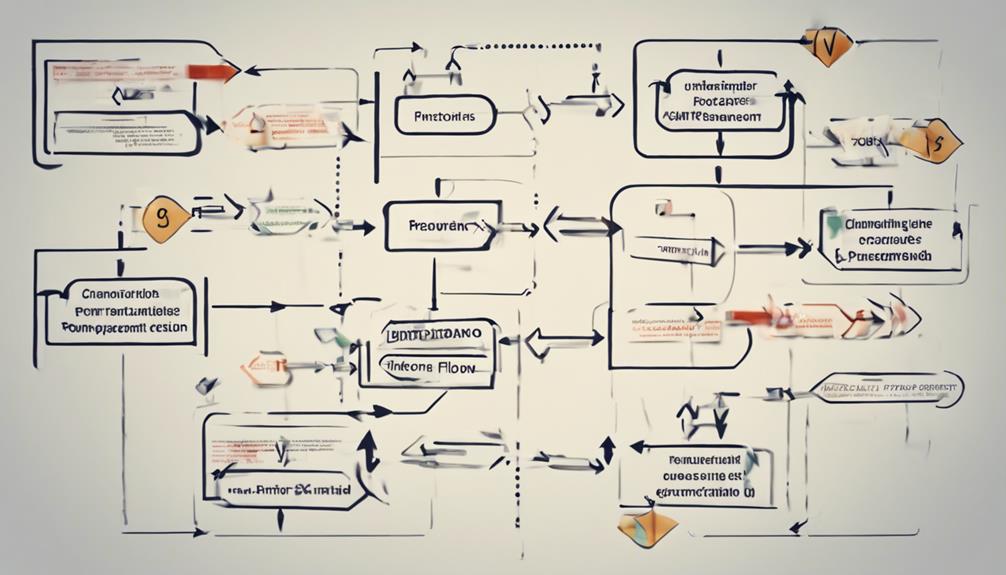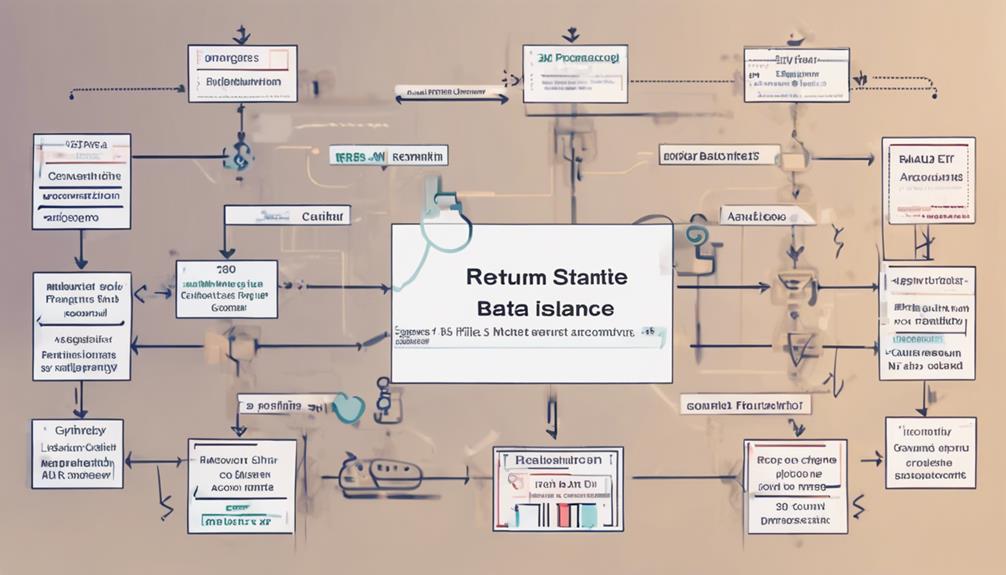Understanding ACH returns is crucial in successfully maneuvering electronic payment hurdles. ACH returns occur when transactions fail to meet set criteria and are sent back through the ACH network. Return codes help identify reasons for failures, initiated by the RDFI within a 60-day timeframe. Distinct from reversals, returns focus on resolving transaction issues following NACHA guidelines. Initiating a return involves notifying the bank promptly, providing transaction details, and deciphering alphanumeric return codes. Prevent return issues by verifying account information, monitoring balances, setting payment controls, and using automated notifications. Mastering these aspects guarantees smoother financial operations. Discover strategies to enhance your handling of ACH returns.
Key Takeaways
- Understand ACH return codes (e.g., R01, R02) to identify transaction failure reasons efficiently.
- Initiate ACH returns within 60 days for failed transactions to rectify issues promptly.
- Implement account verification and monitoring practices to prevent common return reasons.
- Utilize payment controls and notifications to minimize ACH return risks effectively.
- Promptly notify the bank with transaction details to initiate the ACH return process.
Understanding ACH Return Process

Understanding the process of ACH returns is essential for efficient financial management. ACH returns occur when a transaction fails to meet specific criteria and is consequently sent back through the Automated Clearing House network.
These returns encompass both debits and credits, with refunds being directed back to the originating bank. By grasping the various return codes associated with ACH transactions, one can easily pinpoint the reasons behind transaction failures.
It's important to note that ACH returns differ from ACH reversals, as they're initiated by the Receiving Depository Financial Institution (RDFI) due to transaction issues, following guidelines set by NACHA.
A 60-day timeframe exists for initiating ACH returns, offering a structured approach to rectifying failed transactions and ensuring smooth financial operations.
Key Differences: ACH Return Vs. Reversal

Moving from the process of ACH returns, distinguishing between ACH return and reversal initiators sheds light on key differences in electronic payment management.
ACH returns are initiated by the Receiving Depository Financial Institution (RDFI) in response to transaction issues, following guidelines set by NACHA. These returns must be initiated within a 60-day timeframe.
On the other hand, ACH reversals are initiated by the Originating Depository Financial Institution (ODFI) before settlement completion to correct errors. Reversals have a shorter initiation timeframe compared to returns.
Understanding these distinctions is essential for businesses and individuals exploring the world of electronic payments to guarantee efficient financial operations and mitigate risks effectively.
Initiating an ACH Payment Return

To initiate an ACH payment return, notify the bank of the transaction issue promptly. When dealing with ACH return processes, it's crucial to follow specific steps to guarantee a smooth return transaction. Here are some key actions to take:
- Contact the bank to inform them of the need for an ACH payment return.
- Provide all necessary details regarding the transaction and the reason for the return.
- The bank will initiate the return process through the ACH network on your behalf.
- Once processed, the originating bank will be notified, and the necessary adjustments will be made promptly.
Deciphering ACH Return Codes

When decoding ACH return codes, businesses must familiarize themselves with the alphanumeric codes that signify transaction failure reasons. These codes, starting with 'R' followed by two digits, provide valuable insights into why a transaction was unsuccessful.
Common ACH return codes include Insufficient Funds (R01), Account Closed (R02), No Account/Unable to Locate Account (R03), and Invalid Account Number (R04). Monitoring these codes is essential for efficient bookkeeping and operational effectiveness.
Strategies to Prevent ACH Return Issues

Implementing proactive measures can effectively reduce ACH return issues and enhance financial transaction efficiency.
To prevent ACH return problems, businesses can:
- Verify Account Information: Confirm accurate account details to prevent common return reasons like Invalid Account Number (R04).
- Monitor Account Balances: Regularly check account balances to avoid Insufficient Funds (R01) returns.
- Implement Payment Controls: Set limits or pre-authorization requirements to minimize the risk of returns.
- Utilize Automated Notifications: Receive alerts for low balances or failed transactions to take immediate action and prevent returns.
Frequently Asked Questions
Can ACH Returns Be Initiated by the Originating Bank?
ACH returns can't be initiated by the originating bank. These returns are typically initiated by the Receiving Depository Financial Institution (RDFI) due to transaction issues. NACHA guidelines govern the ACH return process, outlining a 60-day timeframe for initiation.
In contrast, ACH reversals are initiated by the Originating Depository Financial Institution (ODFI) before settlement completion to correct errors, with a shorter initiation timeframe. Understanding these distinctions is essential for managing electronic payments effectively.
Are ACH Returns Subject to a Time Limit for Resolution?
ACH returns are subject to a time limit for resolution. According to NACHA guidelines, financial institutions have 60 days to initiate ACH returns. This timeframe guarantees prompt handling of transactions that don't meet the required criteria.
Understanding this deadline is crucial for efficient management of electronic payments and maintaining smooth financial operations. Timely resolution of ACH returns contributes to improved cash flow and reduced risks for businesses.
What Happens if the RDFI Doesn't Process an ACH Return?
If the RDFI doesn't process an ACH return, the originating bank may face challenges. Delays in resolving failed transactions can impact financial operations. It's important for the RDFI to promptly address ACH returns to maintain smooth payment processes.
Timely action guarantees that errors are rectified efficiently, preventing disruptions to cash flow and financial stability. Effective communication and adherence to NACHA guidelines are essential in managing ACH return situations.
Can ACH Return Codes Be Customized by Each Financial Institution?
ACH return codes can't be customized by each financial institution. These codes are standardized within the ACH network to guarantee consistency and clarity across all transactions. Standardization helps streamline the return process and allows for easier identification of transaction failure reasons.
Financial institutions must adhere to these predefined codes to maintain compliance with NACHA guidelines and facilitate efficient handling of ACH returns.
How Do ACH Returns Impact a Company's Credit Rating?
When considering a company's credit rating, ACH returns can impact it negatively if frequent occurrences indicate financial instability. Excessive returns may signal cash flow issues or poor transaction management.
Monitoring ACH return patterns is essential to maintain a positive credit rating. Proactive handling of returns and adhering to NACHA guidelines can help prevent negative effects on a company's creditworthiness.
Understanding ACH return codes and addressing issues promptly is key to safeguarding credit ratings.
Conclusion
To sum up, maneuvering through the world of ACH returns demands vigilance and understanding to guarantee smooth financial transactions.
By decoding ACH return codes and implementing proactive strategies, individuals and businesses can prevent payment hurdles and maintain a seamless flow of funds.
Remember, staying informed and prepared is the key to conquering the vast ocean of electronic payments with finesse and precision, making any obstacle seem as small as a drop in the financial bucket.










